Additional notes (click to expand)
Medicinal
Prescription only medicine: vincristine, vinblastine
Mitotic inhibitors. Contains vincristine and vinblastine, used for childhood leukaemias, lymphomas and nephro-blastomas.
Oakeley, Dr. H.F. (2013). Medicines from RCP plants label list 5-2013.docx.
Formulations and International Trade. The two key pharmaceutical dimeric alkaloid compounds, VBL and VCR, exist mainly in the aerial parts of the plant in extremely low concentrations, the latter quantitatively much less than the former. Vincristine sulfate, originally known as leurocristine, is the only effective antileukemic drug that reduces white blood cell count drastically; since the 1950s, it has increased the survival rate of children with leukemia from 20% to 80%. It is one of the most expensive plant products on the market with considerable side effects. Vinblastine similarly decreases the quantity of white blood cells in the blood. Vinblastine sulfate has now been marketed for more than 40 years as an anticancer drug. It has proven effective against Hodgkin’s disease. Vincristine sulfate and vinblastine sulfate are being sold for a total US$ 100 million per year. Developing food stuff incorporated by fresh leaves of MP gives rise to the economic importance of the herb while such products possess both pharmaceutical and nutritional
properties, simultaneously. These injectable drugs and their semisynthetic analogues such as vinorelbine (VRLB) and vindesine (VDS) interfere with the division of cancer cells. Navelbine (5-noranhydrovinblastine) is a semisynthetic vinca alkaloid with complete microtubule epolymerization ability, broader antitumor activity, and a lower neurotoxicity than VBL and VCR because it electively interferes with tubulin assembly. Fully synthetic vincristine is far less efficient (only 20% efficiency) compared to the natural product derived from MP, and hence the importance of the species and its
bioactive compounds is unchallenged owing to their complex structures. The other valuable therapeutic alkaloid “ajmalicine” is a constituent of hypotensive drugs employed in the treatment of high blood pressure.
Abiriz, R, Naghmeh, N., Alireza, V., Cahill, D., Yee-How, T., Mahmood, M.. (2015). Review Article: Ornamental Exterior versus Therapeutic Interior of Madagascar Periwinkle (Catharanthus roseus): The Two Faces of a Versatile Herb. Hindawi Publishing Corporation. http://dx.doi.org/10.1155/2015/982412
link
Other use
Catharanthus roseus (L.)G.Don Apocynaceae. Madagascar Periwinkle Distribution: Madagascar. It is the source of vincristine and vinblastine, which impair cell multiplication by interfering with microtubule assembly, causing metaphase arrest and are effective medications for leukaemias, lymphomas and some solid tumours. The mortality from childhood leukaemia fell from 100% to 30% once it was introduced - not a drug that could ethically be tested bu double-blind trials. These chemicals were initially discovered by investigators in 1958 who were looking for cures for diabetes so tested this plant which was being used in the West Indies to reduce blood sugar levels.There are 70 different alkaloids present in this plant, and some - catharanthine, leurosine sulphate, lochnerine, tetrahydroalstonine, vindoline and vindolinine - lower blood sugar levels. However, the toxicity of this plant is such that this is not a plant to try at home for diabetic management. The vincristine content of the plant is 0.0003%, so two kilograms of leaf are required to produce sufficient vincristine for a single course of treatment for a child (6gm). Fortunately it is a vigorous weed and easy to grow in the tropics. Artificial synthesis of vinblastine was achieved in 1979, of vincristine in 2004.
Oakeley, Dr. Henry F. (2013). Wellcome Library notes.
link
Decoctions of Madagascar Periwinkle (MP) are mentioned in folklore remedies for treatment of diabetes, malaria, dengue fever, dysentery, insect bites, skin infection, diarrhea, leukemia, eye irritation, dyspepsia, dysentery, toothache, sore throat, and lung congestion. The root of the plant is reported to be a tonic and possess hypotensive, sedative, and tranquillizing properties.
In Ayurveda, it is used for treating diabetes. Hypoglycemic activity of aqueous extracts from MP has been proved in modern studies, as well. In Madagascar, the bitter and astringent leaves have been applied as an emetic; roots have been used as a purgative, vermifuge, depurative, hemostatic
agent and toothache remedy. In the Philippines, the leaf decoction is an herbal treatment for diabetes, young leaves are for stomach cramps, and root decoction is for intestinal parasitism. Mauritians employ infusion of leaves for indigestion and dyspepsia. In India (Orissa and Assam), juices from the leaves are used to treat wasp stings while roots and leaves are utilized as anticarcinogenic agents. MP floral extracts enjoy wide usage in many countries as a remedy for many ailments: Cuba and Jamaica: eyewash for infants; Bahamas: asthma; Bermuda: high blood pressure; Indo-China: dysmenorrhea; Surinam and throughout the Caribbean: eye irritation/infections, malaria, menstrual pains, and diaphoresis. Ugandans put faith in leaf infusions to treat stomach ulcers while Batswana ground leaves in milk for mature abscesses. In Togo, a root decoction is taken to treat dysmenorrhoea. Even in developed countries such as Europe, MP is used as a folk remedy for diabetes for centuries.
In Hawaii, the plant is boiled to make a poultice stop bleeding.
The Chinese have widely applied this versatile herb in the treatment of leukemia, hypertension, lymphosarcoma, and giant follicular lymphoma while adapting it as an astringent, diuretic, and cough remedy. Similarly, in central and south America, it is popular as a homemade cold remedy to ease lung congestion, inflammation, and sore throat while it is trusted as an alternative medical treatment source for leukaemia in Hong Kong and Korea. Japan has targeted MP for arresting diabetes and malignant lymphatic tumours. In addition, modern research has revealed a broad spectrum of medicinal applications for the herb.
Abiriz, R, Naghmeh, N., Alireza, V., Cahill, D., Yee-How, T., Mahmood, M.. (2015). Review Article: Ornamental Exterior versus Therapeutic Interior of Madagascar Periwinkle (Catharanthus roseus): The Two Faces of a Versatile Herb. Hindawi Publishing Corporation. http://dx.doi.org/10.1155/2015/982412
link
Phytochemistry
Two commercially and pharmacologically important cytotoxic dimeric alkaloids of Madagascar Periwinkle (MP), vinblastine and vincristine, have been widely used for cancer chemotherapy, which are only present in extremely low yields in the leaves.
Abiriz, R, Naghmeh, N., Alireza, V., Cahill, D., Yee-How, T., Mahmood, M.. (2015). Review Article: Ornamental Exterior versus Therapeutic Interior of Madagascar Periwinkle (Catharanthus roseus): The Two Faces of a Versatile Herb. Hindawi Publishing Corporation. http://dx.doi.org/10.1155/2015/982412
link
Toxicity
Madagascar Periwinkle (MP) can be dangerous if consumed
orally. It can be hallucinogenic and is cited as such
(under its synonym Vinca rosea) in the Louisiana State
Act 159. TIAs have been applied clinically since the end of
the 1950s as major drugs in the treatment of acute lymphoblastic
leukemia, non-Hodgkin lymphomas, myeloma,
and Hodgkin lymphoma. Despite their benefits, all of the
MP alkaloids have neurotoxic activity, especially vincristine,
affecting neurotransmission. Vincristine and vinblastine
are highly toxic antimitotics, blocking mitosis in metaphase
after binding to the microtubules. Moreover, many side
effects have been reported for these drugs comprising myelosuppression,
alopecia, abdominal cramps, constipation, nausea/
vomiting, paralytic ileus, ulcerations of the mouth, hepatocellular
damage, kidney impairment, pulmonary fibrosis,
urinary retention, amenorrhoea, azoospermia, orthostatic
hypotension, and hypertension. The dosage and
administration must be carefully controlled to reduce side
effects.
Abiriz, R, Naghmeh, N., Alireza, V., Cahill, D., Yee-How, T., Mahmood, M.. (2015). Review Article: Ornamental Exterior versus Therapeutic Interior of Madagascar Periwinkle (Catharanthus roseus): The Two Faces of a Versatile Herb. Hindawi Publishing Corporation. http://dx.doi.org/10.1155/2015/982412
link
Geographical distribution
- Africa, Western Indian Ocean, Madagascar
Podcast
Catharanthus roseus (L.) G. Don
Family: APOCYNACEAEGenus: Catharanthus
Species: roseus (L.) G. Don
Common names: Madagascar Periwinkle
Distribution summary: Madagascar
Habit: Perennial
Hardiness: H2 - Tender; cool or frost-free greenhouse
Habitat: Rocky areas in sparse forests, grassland and open bushland
Garden status: Currently grown
Garden location: Arid zones (Q), Olive tree bed (O), Plants in pots (POT)
Flowering months: June, July, August, September
Reason for growing: Medicinal, toxic, prescription only medicine
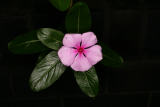
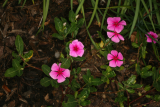
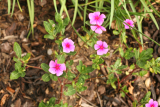
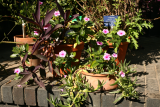

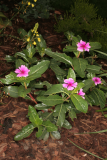
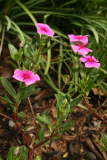
.JPG)
.JPG)
.JPG)
.JPG)